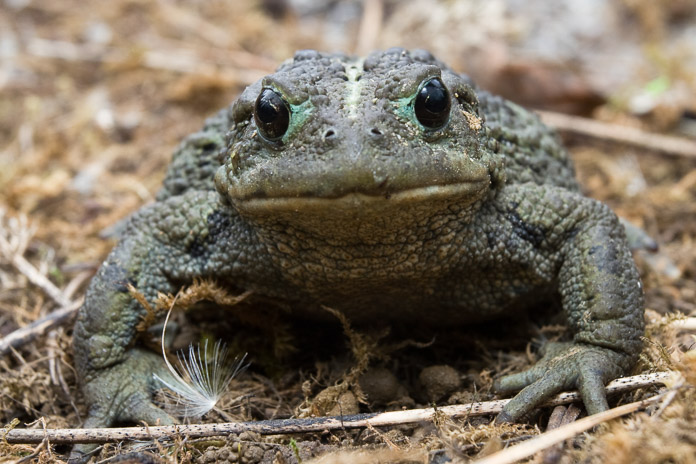
当你想到Glacier Bay(冰川湾)的野生动物时,蟾蜍大概不会在你的列表的顶端。但是蟾蜍很重要。科学家把两栖动物称为“指示性”物种。两栖动物,像这个boreal toad(北方蟾蜍),就对其周围的环境里的小变化极为敏感。20年前,在Bartlett Cove(巴列特湾)的公园总部,如果你去散步,那你很难不踩到一只。而现在,它们特别稀有,以致于公园要求你如果看到了一只,一定要向公园报告。我探索了整个Glacier Bay(冰川湾)四年以后才看到了第一只。当我在搬柴火的时候,偶然发现了这只蟾蜍。幸运的是,我有一个相机在身边而且拍到了几张照片,然后我小心翼翼地把这只蟾蜍头上的木头又放了回去。
Al pensar en la vida salvaje de Glacier Bay, los sapos probablemente no encabezan la lista. Sin embargo, los sapos son importantes. Los científicos se refieren a los anfibios como especies “indicadoras”. Los anfibios, como este sapo boreal, son extraordinariamente sensibles a los pequeños cambios de su entorno. Hace veinte años, era imposible dar un paseo por la sede central del parque en Bartlett Cove, sin pisar alguno. Ahora es tan poco común verlos, que si usted ve uno, el parque le pedirá que le informe de ello. Yo he explorado todo Glacier Bay, y tardé cuatro años a ver mi primer sapo. Me encontré con éste cuando estaba transportando un poco de leña. Afortunadamente, tenía una cámara conmigo y pude tomar unas cuantas fotografías antes de volver a colocar la cubierta de madera bajo la que estaba el sapo.
When you think of Glacier Bay wildlife, toads probably don't top your list. But toads are important. Scientists refer to amphibians as ‘indicator’ species. Amphibians, like this boreal toad, are extremely sensitive to small changes in their environment. Twenty years ago, in the park headquarters at Bartlett Cove, it was difficult to go for a walk without stepping on one. Now, they are so rare that if you see one, the park asks that you report it. I have explored all over Glacier Bay and it was four years until I saw my first one. I stumbled upon this toad when I was moving some firewood. Fortunately, I had a camera at my side and I was able to take a few shots before carefully replacing the toad’s wooden roof. Photographer: Sean Neilson